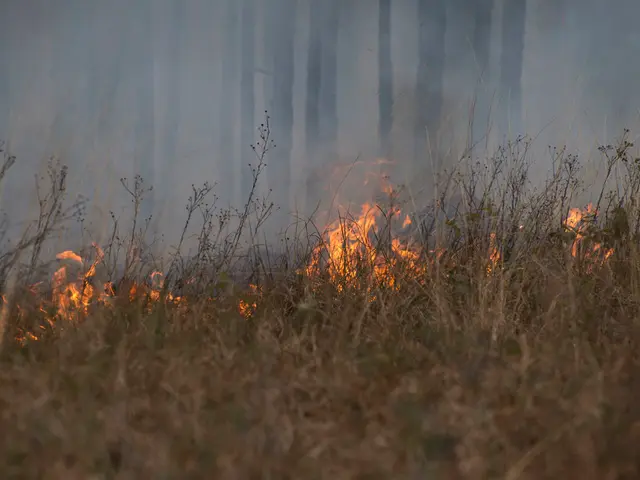Heavy Rainstorms in South Korea Result in Tragedy: Flash Floods Result in the Death of 19 Individuals and Path of Devastation
In the aftermath of the devastating floods in South Korea in July 2025, recovery efforts are underway, particularly in the hardest-hit areas such as Sancheong County, South Gyeongsang Province.
Sancheong, which experienced around 600 to 800 mm of rainfall in five days, severely overpowering the existing drainage systems, was one of the areas hit hardest by the floods. The deluge resulted in at least 10 confirmed deaths and 4 missing persons in Sancheong alone.
The floods caused extensive damage, with nearly 12 inches of rain falling in one day, leading to severe landslides and infrastructure damage, including to homes, roads, and farms. The overall flood damage nationwide was severe, with over 24 fatalities or missing persons and more than 4,000 facilities damaged. Approximately 447 homes were destroyed and 4,480 flooded, with nearly 3,056 hectares of farmland submerged and significant livestock losses.
The government has deployed large-scale aid to assist with the recovery. Emergency response included evacuations and deployment of special forces to assist with recovery efforts, especially in flood-damaged homes. Authorities issued urgent warnings to residents to remain alert due to ongoing risks of landslides and flooding. The government also considered designating affected areas like Sancheong as special disaster zones to unlock emergency funding and support.
Recovery efforts involve repairing damaged infrastructure, restoring power, addressing agricultural losses, and supporting displaced or affected residents. South Korea has documented over 6,700 reports of infrastructure damage since the floods began on July 16, 2025. Gapyeong, another affected area, received 173 mm of rain in 17 hours on July 20 to 21, breaking a record set in 1998 for total rainfall in South Korea during that same time period.
Recovery costs are the highest in a decade for a natural disaster in Korea, reflecting the massive scale and severity of the floods. Some local events and festivals in the affected provinces were postponed or canceled out of respect for recovery efforts, showing the ongoing social impact of the floods.
As of July 22, 2025, at least 19 people have died and 9 are missing due to the floods and landslides in South Korea. Over 14,000 residents have been displaced due to the floods. Psychological support services assisted hundreds of people.
For real-time updates, visit the National Disaster and Safety Portal. To help with the relief efforts, donate to the Hope Bridge Korea Disaster Relief Association or Give2Asia: South Korea Flood Response. To avoid visiting affected areas, call 119 for fire/ambulance and 112 for police assistance.
President Lee organized emergency operational sites to coordinate military troops and emergency agencies for search and rescue, recovery, and the delivery of relief supplies. Some areas in South Korea still have warnings in effect. Check with the Korea Meteorological Administration for updates.
In summary, Sancheong and South Gyeongsang Province remain in active recovery mode with large-scale government aid deployed, urgent infrastructure repairs underway, and continuing vigilance against further landslides or flooding due to the severity of the event in July 2025.
[1] Yonhap News Agency. (2025). South Korea floods: Rescue efforts continue in hardest-hit areas. [online] Available at: https://en.yna.co.kr/view/AEN20250720005150325
[2] The Korea Herald. (2025). South Korea floods: Government allocates 2.7 trillion won for recovery efforts. [online] Available at: https://www.koreaherald.com/business/economy/2025/07/21/south-korea-floods-government-allocates-27-trillion-won-for-recovery-efforts/
[3] Reuters. (2025). South Korea floods: Government considers designating disaster zones. [online] Available at: https://www.reuters.com/world/asia-pacific/south-korea-floods-government-considers-designating-disaster-zones-2025-07-21/
[4] The Korea Herald. (2025). South Korea floods: Local events postponed or cancelled out of respect for recovery efforts. [online] Available at: https://www.koreaherald.com/nation/2025/07/21/south-korea-floods-local-events-postponed-or-cancelled-out-of-respect-for-recovery-efforts/
- The environmental impact of the floods in South Korea is a topic of ongoing research, with the disaster causing significant damage to farmland and disrupting local ecosystems.
- In an effort to promote sustainability and reduce carbon footprint, environmental groups are organizing green courses and events to educate the public on the importance of ESG (Environmental, Social, and Governance) principles in recovery efforts.
- Apart from the physical destruction, the floods in South Korea have also resulted in general-news reporting focusing on the recovery, accidents, and weather-related risks that persist in the affected areas.
- Sustainability experts have stressed the importance of incorporating ESG considerations in the reporting and research of these events, as this approach can help ensure long-term resilience and prevent future disasters.
- As part of the recovery efforts, South Korean authorities have committed to prioritizing the implementation of green infrastructure, using the experience from this devastating event as a catalyst for promoting a more sustainable and disaster-resilient future.








